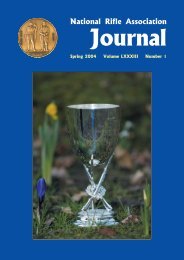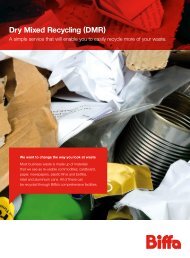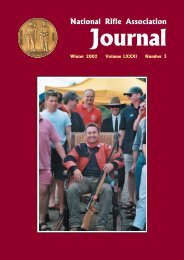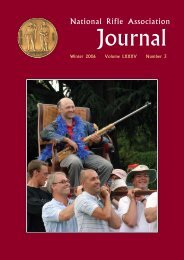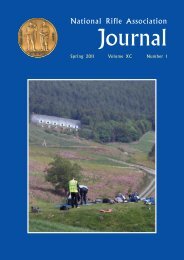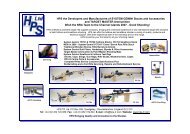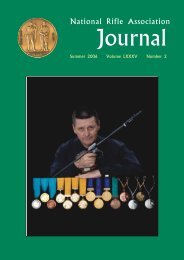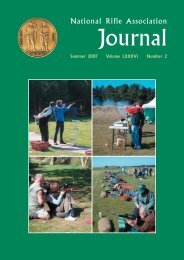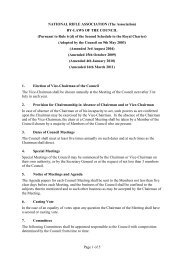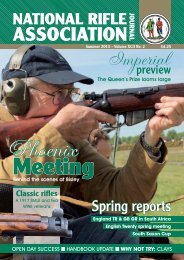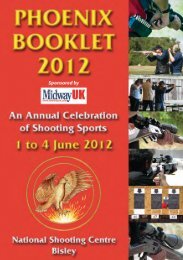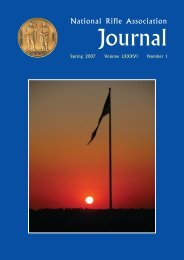NRA Journal - Summer 2003 - National Rifle Association
NRA Journal - Summer 2003 - National Rifle Association
NRA Journal - Summer 2003 - National Rifle Association
- No tags were found...
Create successful ePaper yourself
Turn your PDF publications into a flip-book with our unique Google optimized e-Paper software.
LETTERSFrom Stephen BrooksRevival of the Palma Trophy CompetitionThis year the Palma World Long Range Championshipwill take place at Bisley and I thought it timely to providesome insight into the revival of this match in the 1960ssince I happened to be a bystander. I joined the ManitobaProvincial <strong>Rifle</strong> <strong>Association</strong> in 1964, while anundergraduate at the University of Manitoba. In 1965 Iwas part of the contingent from Manitoba, which shotin the Tri-Provinces shoot in Dundurn, Saskatchewan.Following the usual general meeting, Colonel SteveJohnson (whom I had previously met in Barbados in themid fifties, when he was part of the Canadian teamtouring the West Indies at the same time that Cliff Mallettwas touring with the Devon-Jersey team) spoke to usabout his ideas of reviving the Palma Trophycompetition as the highlight of shooting events plannedfor the Canadian Centennial in 1967. The aims were toensure that:1 The match was recognized as an internationalevent;2 The match enhanced the position of the DCRA andits members in the overall <strong>National</strong> celebrationsfor the Centennial;3 The match would return to its rightful position inthe World’s Calendar of Shooting the once highlyregarded Palma Trophy Match.Steve informed us that he had approached Jim Whitneyfrom California, the leader of the American shooterscompeting in rifle shooting in Canada at that time, totest the feasibility of such an event. To move mattersforward, Steve was asked to contact Admiral Mustin ofthe <strong>NRA</strong> of America. The result of these discussionsresulted in the test match being arranged for 1966 inCamp Perry.Of equal importance to Steve was the need to establishthis match as the ‘ultimate’ test of marksmanship. Inthose days we were still using service rifles ormodifications of service rifles and I remember the firstmatch in 1967 in Ottawa when team members were ableto draw the rifle they would later use in the match, takeit away and sight it in prior to the start of the match. Iam lucky to have fired in the last match when those ruleswere followed (Ottawa 1982) and the first match in whichthe rules permitted team members to use their own rifles(Bisley 1985).At that meeting in Dundurn there was a very goodyoung marksman who had recently won the GrandAggregate at Bisley and who was about to leave theRCAF. His friendship has been highly regarded by me,and of course I am speaking of Bob Pitcairn. There wasalso a young ex-Rhodesian markswoman who hadrecently come to Canada and who also was part of that1967 team and who has been a constant friend of minedown the years, and has helped me blow off the dust ofyears regarding this event. Of course I am referring toDoran Sewell, nee Westhead, who referred my enquiryto Col Bill Strachan and asked him if he rememberedthose early days. His involvement at that time andmemory of these events produced the final whisk.To prepare Provincial <strong>Rifle</strong> <strong>Association</strong>s for the PalmaMatch, inter-provincial matches were held across thecountry on a postal basis. The winning team memberswere presented with a very handsome badge, and amongmy treasured trophies is such a badge, which I won whileshooting for British Columbia in 1968.I am certain that Steve would approve of the manner inwhich the Palma Trophy Competition has developedduring the interim period.From Peter CampbellProposal to amend the <strong>NRA</strong> Rule defining theMatch <strong>Rifle</strong>As the person mentioned in Richard Kenchington’sarticle in the Winter 2002 <strong>Journal</strong>, I had hoped thatsomeone else would have replied to his thoughts, but asno-one did then here I go.Match <strong>Rifle</strong> (MR) is probably the most gentlemanlyshooting discipline I have ever competed in although Iwould disagree with calling MR the Formula One oftarget shooting. One glance would see that F Class isbecoming the fastest evolving rifle discipline; havingheld its first World Championship in 2002 and a seconddue in South Africa in 2004.Changes to F1 motor racing are invariably done for safetypurposes and largely have the aim of slowing the cars. Ifear opening the floodgates to cartridge developmentwould not necessarily be one of safety for MR. Richardspeaks of those with other calibres being ableimmediately to compete, whilst expecting that thosewithout would plod along with their existing calibreuntil barrel wear necessitated a barrel/calibre change.This assumes that MR shooters are happy to plod alongin mediocrity; plainly my experience of MR shooterswould dispel that assumption! There would be an armsrace, where the gun-plumbers and barrel makers wouldbe very happy and all but those with the deepest pocketswould struggle to be competitive.A comparison of the respective accuracy between .308(MR) and 6.5x55 Ack Imp (F Class), but shot in a MRposition, is easy to provide. During last Autumn’sEnglish VIII MR Meeting my MR and F Class rifle werein simultaneous use on the Sunday with three or fourfiring points separation. While I struggled to keep a 1minute elevation at 1,200 yards, the F Class rifle provideda ¼ minute elevation with ease. Moving to windestimation the wind corrections showed the 6.5mm using25% less wind than the MR, so contrary to Richard’s viewthat there would be no significant advantages to begained by those moving away from .308, there plainlywould be. Why would anyone want to go to the expenseof re-tooling for anything less than a significant gain?61



